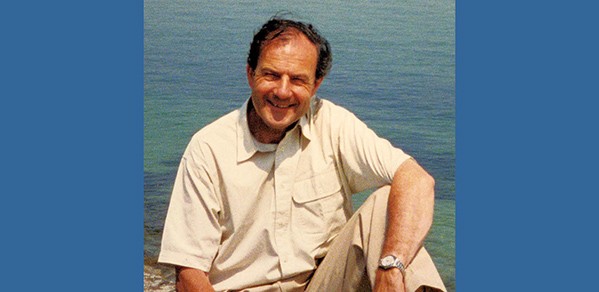
To recognise Robin Jackson’s significant contributions to Design Education and Rehabilitation Robotics, a permanent Robin Jackson Design Fund has been created.
Robin was an excellent teacher and researcher, recognised for his kindness and willingness to help others. He made many contributions to teaching, including being a key member of the team that developed the second-year Integrated Design Project. He was a pioneer in the field of Rehabilitation Robotics, helping to improve the lives of many disabled people.
Ken Wallace, Professor Emeritus of Engineering Design, University of Cambridge
After graduating from Trinity Hall, Robin completed his National Service before working for a period in industry. In 1965, he was appointed Lecturer in Electrical Engineering and elected a Fellow of Selwyn College. In 1995, Robin fell ill and, very sadly, died, aged 57.
Robin made a large number of significant contributions to the Department. He was an extremely conscientious and very popular teacher. When the Engineering Tripos was reformed into the current 4-year MEng course in the early 1990s, he was a key member of the team that set up the 2nd year Integrated Design Project (IDP), which ran for the first time in October 1993.
Many of his research efforts were directed at improving the lives of disabled people and he became a pioneer and world leader in Rehabilitation Robotics.
He was extremely self-effacing and his obituary in the Selwyn Calendar ended: ‘He will be remembered … as a man who did much good quietly.’
To recognise Robin’s significant contributions to Design Education and Rehabilitation Robotics, a permanent Robin Jackson Design Fund has been created in the Department’s Dyson Centre for Engineering Design.
The Fund will:
- offer grants, not usually exceeding £500, to support promising extra-curricular individual or group design projects (total annual sum not usually exceeding £1000)
- be primarily directed at undergraduates in the Engineering Department, but will not exclude research students in the Department
- give priority to projects that contribute in the areas of rehabilitation and medical applications or generally improve the quality of human life
- give priority to projects that will deliver a tangible result
- be administered by the Manager of the Dyson Centre
Applications should be made using the document “Application Form: Robin Jackson Design Fund”, available from the Dyson Centre website www.dysoncentre.eng.cam.ac.uk Queries should be sent to dyson-manager@eng.cam.ac.uk
A Note on Robin Jackson’s Contribution to Rehabilitation Robotics
Dr Ray Gosine - written in 1995
Rehabilitation robotics is a field of research and development of technology that can provide increased independence for people with severe physical disabilities. Applications of such technology attempt to help overcome barriers to employment, education and independent daily living. Over the past 15 years the field of rehabilitation robotics has grown from a handful of university researchers undertaking small R&D projects into an established research field with international collaborative projects and conferences. Robin Jackson was one of the first people to engage in this research and he made significant contributions to the international growth and establishment of the field.
Robin’s work in rehabilitation robotics began in the early 1980s with the financial support of the Milly Apthorp Charitable Trust. Robin initiated a project with the Dr Barnardo’s New Mossford School that developed a robot system for use by physically disabled children in early education applications. This collaboration was the basis for Robin’s research in several areas (robot vision and sensors, robot control, and human-robot interface techniques) with additional funding from the Spastics’ Society and Action Research. These research projects contributed technology components for robot control software called Cambridge University Robot Language (CURL) that was marketed by a high-technology company in the UK. In developing and testing CURL, Robin collaborated extensively with researchers in Canada, USA, Australia, Sweden, France, and The Netherlands.
The Papworth Group saw significant value in furthering Robin’s work, and in 1990, joined a major collaborative project funded by ACME to develop a robot system called Interactive Robotic Visualisation Inspection System (IRVIS) that could be used as an employment aid for adults with severe physical disabilities. This project was the basis for further research on interface development and robot programming and control which was supported by the Leverhulme Trust, The European TIDE Programme and EPSRC. Robin made significant contributions to several European collaborative projects (Sweden, France, The Netherlands), and enthusiastically pursued these initiatives until his illness forced him to stop working.
Robin organised the very successful workshops on rehabilitation robotics which were held at Selwyn in 1989, 1991 and 1994. These initiatives were significant in bringing together the major international researchers in the field to address the outstanding issues at the time. Through these initiatives, his research contributions, and his encouragement and support of other researchers, Robin became recognised as a leader in the international rehabilitation robotics research community.
Many will remember Robin as a kind and gentle man. These characteristics were also clear in his research activities. Through his research in rehabilitation robotics, he saw the opportunity to apply his engineering expertise in a fashion that would be of great social benefit. His success in rehabilitation robotics can be attributed to more than simply engineering innovation. In part, Robin’s success resulted from an ability to work with and understand academics and professionals of varying backgrounds. Perhaps most importantly, Robin took the time to understand the challenges faced by people who would ultimately use technology for greater independence.

